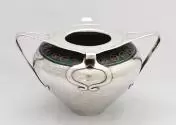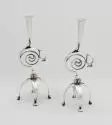A Beginner’s Guide to British A&C Silver: Part 1

At Olympia, Anthony gave a lecture titled “British Arts and Crafts Silver: Pioneering Modernism”, that summarized much of his research into this area to date. Anthony’s particular focus is how this silver contributed to the birth of modern design, pre-dating, and indeed influencing, the better known work of the Wiener Werkstatte or Georg Jensen for example. Additionally, he focuses on how important the Arts and Crafts guilds or workshops were in heralding modern industrial organization, even though they were perceived as utopian failures at the time.
His website www.thepeartreecollection.com now hosts a specific Research section that holds a video of this lecture and also a lecture he gave in 2014 as part of the Archibald Knox 150th Anniversary Exhibition, which Anthony also curated. For those interested in the Arts and Crafts period, this material, together with his published articles also hosted on the website, provide an invaluable introduction to the silver of the period.
Anthony’s research started when he bought a radical pair of candlesticks (Top photo) hallmarked for 1898 and made by the firm of William Hair Haseler. Curious that such design should predate the famous London store Liberty & Co’s silver “Cymric” range, Anthony set about establishing the provenance of the candlesticks.
His research provided concrete evidence that the firm of William Hair Haseler, with the help of a local watercolorist and family friend, Oliver Baker, started to produce radical Arts and Crafts silver in 1898. Unable to sell any of these designs, Haselers ultimately found a like minded patron in the avant garde London retailer Liberty and Co. The Cymric silver range was thus born in which the two firms were partners. These early wonderful designs (bottom photo) by Baker were then subsumed into the Cymric range and obscured both by Liberty’s branding and the emergence of the brilliant Archibald Knox, whose designs post 1900 dominated the range.
Anthony has, subsequent to this first research, drawn together more analysis on the origins of the Liberty Cymric range and early Arts and Crafts silver in general. His lecture at Olympia drew this together in a timeline of British Arts and Crafts silver that we will summarize in next week’s Collector’s Guide article so stay tuned!
The timeline begins with the less well known Keswick School of Industrial Art who were the first Arts and Crafts silver producers in 1888 and hold claim to a 100 year history, ultimately closing in 1984 having survived their nearest competitor guild or school by nearly 50 years. The timeline also focuses on Charles Ashbee’s Guild of Handicrafts who started to craft silver as early as 1888 and who, apart from producing some of the most exciting silver of the period, also showed the world the benefits of organizing as a guild, heralding modern day themes of worker participation, broad equity ownership and manufacturing and design integration.
Altogether Anthony discusses some fifteen designers and silversmiths of the period who produced relatively few works, principally in the period 1895-1914. Today these are some of the most prized collecting areas in silver, and in British Arts and Crafts, with the best pieces commanding prices over ten thousand dollars, with Archibald Knox’s most important works reaching six figures.
In next week’s article, we will publish a brief Beginner’s Guide and Timeline of these key designers and silversmiths, which includes, in addition to those mentioned above, such designers and silversmiths as Omar Ramsden and Alwyn Carr, Gilbert Leigh Marks, Nelson and Edith Dawson, the Artificers Guild and John Paul Cooper. We’ll see you next week for more on British Arts and Crafts Silver!
Examples of work from this period can be found at the following London galleries’ websites:

